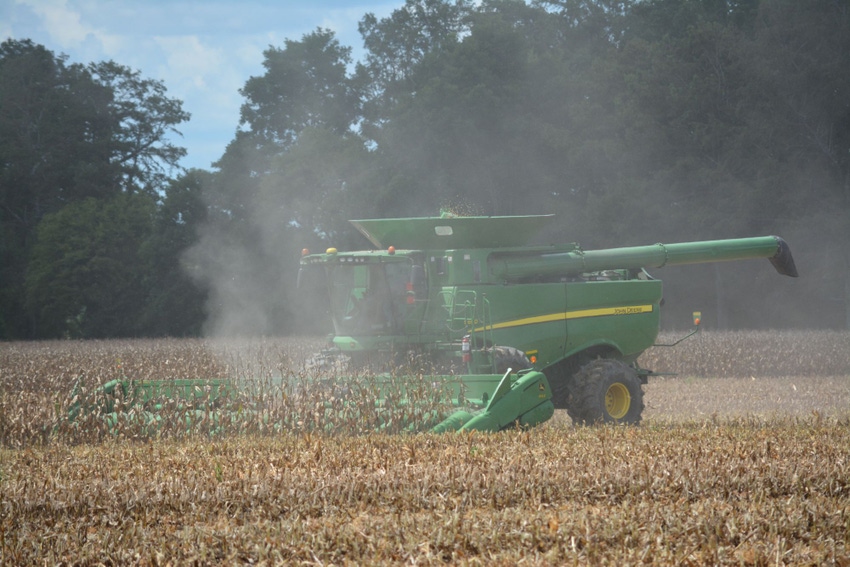August 12, 2016

U.S. farmers are expected to harvest 11 percent more corn in 2016 compared to 2015 with favorable weather conditions pushing corn yields to 175 bushels per acre, the highest on record for the U.S.
The forecast in USDA’s first survey-based crop production report issued today (Aug. 12) was expected to add more bearishness to already slumping corn futures as U.S. elevators try to figure out what to do with a 15.2-billion-bushel corn crop, also the highest on record.
USDA’s National Agricultural Statistics Service is also forecasting a record U.S. soybean crop of 4.06 billion bushels, which would be up 3 percent from 2015. Yields are expected to average a record 48.9 bushels per acre nationally. That would be from a record 83 million acres of soybeans, up 1 percent from 2015.
The U.S. cotton crop is forecast to total 15.9 million bales, which would be up 23 percent from 2015. Upland cotton production is projected to reach 15.3 million bales, also up 23 percent from last year, and Pima or extra-long-staple cotton is forecast at 565,000 bales, up 30 percent from 2015.
U.S. rice producers are expected to harvest 244.32 million hundredweight of all classes of rice, which would be up 52 million hundredweight from 2015. Long grain rice could reach 182.7 million hundredweight, up nearly 50 million hundredweight from 2015, and medium grain 58.4 million hundredweight, up almost 2 million hundredweight from last year.
Sorghum acreage down
As expected, USDA is forecasting grain sorghum production will be down, falling from 2015’s 596.75 million bushels to 474.68 million in 2016. Area harvested is expected to be down to 6.45 million acres following last year’s run-up to 7.85 million due to higher price offerings for grain sorghum.
U.S. peanut production is forecast at 6.1 billion pounds, down 100 million pounds from 2015’s 6.2 billion pounds on 1.53 million acres
USDA’S NASS said 76 percent of the U.S. corn crop was reported in good to excellent condition on July 31, up slightly from July 3 and 6 percentage points above the same time last year.
“Midwestern growing conditions remained mostly favorable, despite a brief, mid-month surge of heat and humidity that increased discomfort levels for livestock, NASS officials said in their July Weather Summary.
“On July 31, more than three-fourths of the U.S. corn and 72 percent of the soybeans were rated in good to excellent condition. Showery July weather prevailed across the heart of the Midwest, although drought remained a problem in parts of Michigan, Ohio and South Dakota," the officials said.
Hot, dry in South
Although hot, dry conditions were the rule in much of the Mid-South and Southeast, USDA said the southern states would be harvesting a good corn crop once again with Arkansas leading the way with a state-wide average of 189 bushels per acre, up from 181 bushels per acre in 2015.
Louisiana’s statewide average was expected to reach 178 bushels, up seven bushels from 2015. Mississippi’s statewide average was expected to decline slightly to 172 bushels from 175 last year, primarily due to dry conditions in June. Tennessee’s statewide average was expected to hit 155 bushels compared to 160 in 2015.
Arkansas’s soybean yield is projected to be off slightly, falling to 47 bushels from last year’s 49; Louisiana’s is forecast at 50 bushels, up nine from last year’s 41 bushels; Mississippi’s at 47 bushels, up one bushel from 2015; and Tennessee’s 46 bushels, the same as 2015’s.
Mississippi’s cotton yield is expected to total 1,133 pounds of lint per acre, up from 1,024 in 2015; followed by Missouri’s at 1,124 pounds, up from 1,097 pounds; Arkansas at 1,052 pounds, down from 1,092 pounds; and Tennessee’s 1,000 pounds, down from 1,046 pounds..
To learn more about the August Crop Production Report, visit http://bit.ly/2bd7leq.
About the Author(s)
You May Also Like






